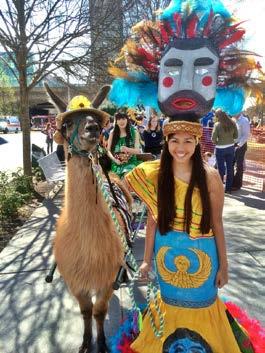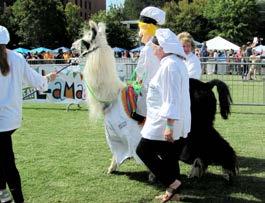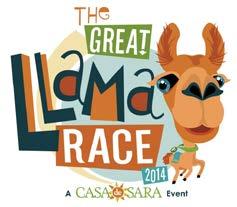
3 minute read
by Susan Gawarecki
The Great Llama Race
by Susan Gawarecki
Advertisement
Pathfinder Farm • Anderson TN
Good Old Smiley pulls his cart in the 2014 costume parade. Photo by Maylene Hall
Lori Santoro had an idea. Her nonprofit organization, Casa de Sara, provides education and health care for Hispanic and Indigenous children in the Americas. What better way to publicize and raise money for this organization which began with schools in Bolivia than to showcase Bolivia’s national animal, the llama? And so was born the Great Llama Race, first held in 2014 in Knoxville’s World’s Fair Park.
Santoro partnered with Southeast Llama Rescue to publicize the event to area llama owners, and SELR used to opportunity to showcase adoptable llamas and alpacas. Response from the Southern States Llama Association membership was tremendous, and participation has grown annually from the 26 initial racing llamas in five heats to 33 llamas in seven heats in 2016.
Not only do educational and health-related projects in Bolivia, Guatemala, Haiti, and Honduras benefit from the fundraising, so do local schools. And this is where the racing llamas come in. Each llama represents a participating high school and two major sponsors. The participating kids “decorate” their llama for a parade, with prizes given for the best costumes. Then the llamas are changed into their saddle pads, and the heats begin. The llamas are led by local celebrities, making the event even more interesting. Races are run on a 100-meter U-shaped course, and the winners move on to the final race of the day. The top three finishers win substantial cash prizes for their sponsoring schools.
Crowds fill the World’s Fair Park gawking at the llamas in their portable stalls, meeting roving llama ambassadors, enjoying live music, and patronizing numerous vendors selling food, camelid-fiber items, llama gee-gaws, and much more.


Llamas and runners make the turn in the 2016 Great Llama Race. Photo by Susan Gawarecki
The races are exciting and often amusing, and by the final race, five fast and willing llamas are eager competitors with a frenzied crowd cheering them on.
To my knowledge, there has never been a llama event in the southeast with as much public exposure as the Great Llama Race. With an estimated 5000 people in attendance at the first event, the llama community could not have asked for better public relations. And WOW, do those PR llamas work overtime at this all-day affair! Little kids lead llamas through an obstacle course, pack llamas meander through thick crowds, llamas are decked out in awkward student-designed costumes, and pasture ornaments are towed around a race course by complete strangers. So successful was the 2014 event that it was immediately called “First Annual.” The ongoing success of the Great Llama Race is testament to the support of the llama community and interest of the public. Look for the Fourth Annual Great Llama Race in October 2017.


7
About the author: Susan Gawarecki has owned llamas since 1995, and they remain her continuing passion. A long-term member of the Southern States Llama Association, she showed llamas for many years in halter and performance classes. She is currently the east Tennessee adoption coordinator for Southeast Llama Rescue and serves on their board of directors. Susan is also on the board of the Pack Llama Trail Association and participates regularly in pack trials in the southeast. She has served as president of the Tennessee Llama Community and edited the newsletters for TLC and SSLA. Additionally she has trained two driving llamas, has a small fiber business, and shears llamas and alpacas for numerous clients. Outside of her llama life, Susan holds a doctorate in Geology and has extensive experience in the environmental consulting industry.










